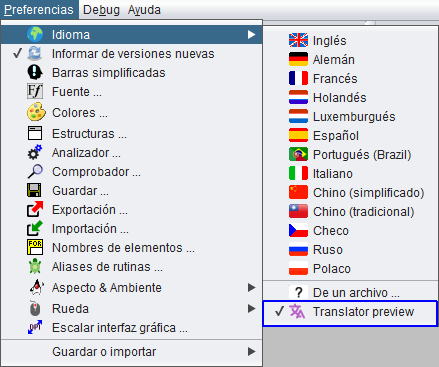|

This preference (the menu item went to top with version 3.29-03, it had been "buried" near the end of the menu before) is responsible for the language of the graphical user interface. This preference is saved automatically. The menu item of the currently selected language is marked in a way depending on the selected Look and Feel, e.g. as a selected checkbox.
The set of translations and adaptations (e.g. menu mnemonics) associated to a certain language is called a locale.
The separated menu item " From file ..." (see image) allows you to load a locale file from your file system instead of one of the predefined translation sets provided by the menu. Such a locale file is a text file containing translations to an arbitrary language. It must of course adhere to a certain format and can be created or derived from an existing locale by means of a maintenance tool being part of Structorizer since release 3.25, called Translator (to be found in the File menu). This way, you are enabled (and invited!) to accomplish existing locales or to create new language files usable here. In Translator, you can advise a preview of the currently edited locale. While the preview is active, you will see a selected additional menu item in the preferences submenu: From file ..." (see image) allows you to load a locale file from your file system instead of one of the predefined translation sets provided by the menu. Such a locale file is a text file containing translations to an arbitrary language. It must of course adhere to a certain format and can be created or derived from an existing locale by means of a maintenance tool being part of Structorizer since release 3.25, called Translator (to be found in the File menu). This way, you are enabled (and invited!) to accomplish existing locales or to create new language files usable here. In Translator, you can advise a preview of the currently edited locale. While the preview is active, you will see a selected additional menu item in the preferences submenu:

You can end the Translator preview by selecting another menu item here (this will remove the extra item; the preview can only be reactivated from Translator).
Please notice that the language of the graphical user interface is independent of the syntax you use in your diagrams and vice versa! Some may prefer having an English user interface but all diagrams they draw need to be in French. Others might want to work with the GUI in their mother tongue while the diagram contents are written in English.
Hint: Several locales (language files) aren't quite complete (i.e. they haven't kept track with the many product enhancements of he last couple of years). The captions and messages for the most essential features are translated, however, GUI controls and messages with missing translations will usually be presented in English (which is the default locale). Sometimes, though, particularly after having changed the language, they may stick with the language previously used. In order to see at least English translations, switch to English and then back to your favourite language.
Since version 3.29-03, a welcome dialog will come up when you use Structorizer the first time; it offers the initial language choice — so you can't miss it:

When you select a language button then Structorizer will immedialtely change the menu captions etc. and also the language of the welcome pane:

If the chosen locale is not complete then the welcome text may still be in English but you will usually see an invitation to help accomplish the locale, advising to use the built-in Translator:

If you are a native or experienced speaker of a language, for which some translations are missing, defective, or wrong in Structorizer, then please don't hesitate to report the defective captions (e.g. as bug reports), to propose proper translations, or (even better still) feel invited to contribute to the accomplishment by producing an updated language file using the Translator and sending that file in. |

